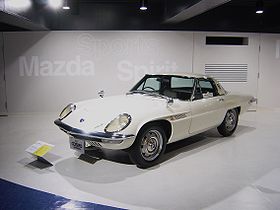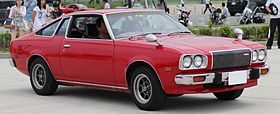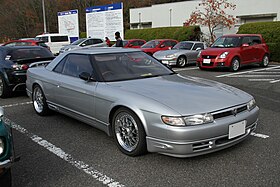Mazda Cosmo
| Mazda Cosmo | |
|---|---|
 |
|
| Overview | |
| Manufacturer | Mazda |
| Production | 1967–1996 |
| Assembly | Hiroshima Assembly, Hiroshima, Japan |
| Body and chassis | |
| Class | Sports car |
| Body style | 2-door coupé 4-door sedan (1981-1990) |
| Layout | FR layout |
| Series L10A/L10B | |
|---|---|
 |
|
| Overview | |
| Production | 1967–1972 |
| Designer | Heiji Kobayashi, Kenichi Yamamoto |
| Body and chassis | |
| Body style | 2-door coupé |
| Layout | front engine, rear drive |
| Powertrain | |
| Engine | 982cc 0810 (Series I), 110hp 982cc 0813 (Series II), 130hp |
| Transmission | 4-speed manual 5-speed manual |
| Dimensions | |
| Wheelbase | 2,200 mm (86.6 in) |
| Length | 4,140 mm (163.0 in) |
| Width | 1,595 mm (62.8 in) |
| Height | 1,165 mm (45.9 in) |
| Curb weight | 940 kg (2,072.3 lb) |
| Series CD | |
|---|---|

Mazda Cosmo AP
|
|
| Overview | |
| Also called | Mazda RX-5 Mazda 121 |
| Production | 1975–1981 |
| Body and chassis | |
| Body style | 2-door coupé 2-door fastback |
| Layout | front engine, rear drive |
| Related | Mazda Luce |
| Powertrain | |
| Engine | |
| Dimensions | |
| Wheelbase | 2,510 mm (99 in) |
| Length | 4,475–4,545 mm (176–179 in) |
| Width | 1,685 mm (66 in) |
| Height | 1,325 mm (52 in) |
| Curb weight | 2,469 lb (1,120 kg) |
| Series HB | |
|---|---|
 |
|
| Overview | |
| Also called | Mazda 929 (1982–1986) |
| Production | 1981–1989 |
| Body and chassis | |
| Body style | 2-door Coupé 4-door Sedan |
| Related | Mazda Luce |
| Powertrain | |
| Engine | 1.8 L VC SOHC I4 2.0 L MA SOHC I4 2.0 L FE SOHC I4 1.1 L 12A 1.1 L 12A Turbo 1.3 L 13B-RESI 2.2 L S2 Diesel I4 |
| Dimensions | |
| Wheelbase | 2,615 mm (103 in) |
| Length | 4,640 mm (183 in) |
| Width | 1,690 mm (67 in) |
| Height | 1,340 mm (53 in) |
| Curb weight | 1,135 kg (2,502 lb) |
| Series JC | |
|---|---|
 |
|
| Overview | |
| Production | 1990–1996 |
| Body and chassis | |
| Body style | coupé |
| Layout | FR layout |
| Related | Mazda RX-7 |
| Powertrain | |
| Engine | 654x2 cc / 1,308 cc (80 cu in) 13B-RE 654x3 cc / 1,962 cc (120 cu in) 20B-REW |
| Transmission | 4-speed automatic |
| Dimensions | |
| Wheelbase | 2,750 mm (108 in) |
| Length | 4,815 mm (190 in) |
| Width | 1,795 mm (71 in) |
| Curb weight | 1,490 kg (3,285 lb) – 1,640 kg (3,616 lb) |
The Mazda Cosmo is a grand touring coupé that was produced by Mazda from 1967 to 1995. Throughout its history, the Cosmo served as a "halo" vehicle for Mazda, with the first Cosmo successfully launching the Mazda Wankel engine. The final generation of Cosmo served as Mazda's flagship vehicle in Japan, being sold as the Eunos Cosmo through its luxury Eunos division in Japan.
Mazda chose to use the name "", reflecting international cultural fascination with the Space Race, as Mazda wanted to showcase the rotary engine as forward-thinking, with a focus on future developments and technology.
The first Mazda to bear the Cosmo name (called the 110S on models intended for export) was the first 2-rotor rotary engine powered series car. A prototype was introduced at the 1964 Tokyo Motor Show, one month before the 1964 Summer Olympics, and after the introduction of the German made NSU Spider also in 1964 at the Frankfurt Motor Show, and 80 pre-production Cosmos were produced for the Mazda test department (20) and for dealership testing (60) between 1965 and 1966. Full production began in May 1967 and lasted through 1972, though Cosmos were built by hand at a rate of only about one per day, for a total of 1,519 (343 Series I cars and 1,176 Series II cars). The car was also featured in the show The Return of Ultraman.
Cosmos were built in five batches:
In 1968, Mazda went racing with the Cosmo. They selected one of the most grueling tests in Europe to prove the reliability of the rotary engine, the 84-hour Marathon de la Route at the legendary Nürburgring circuit in Germany. Two mostly stock Cosmos were entered, along with 58 other cars. One major change to the cars' 10A engines was the addition of a novel side- and peripheral-port intake system: A butterfly valve switched from the side to the peripheral port as RPMs increased. The engines were limited to 130 PS to improve durability.
...
Wikipedia
